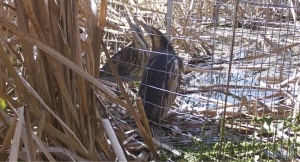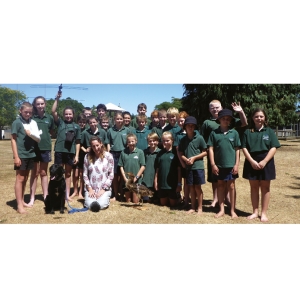Displaying items by tag: Tracking
Hunt for the puweto
The secret life of male bitterns
Finally revealed by DU transmitters
It’s not all boom and gloom
It’s autumn and we’re hunting for Australasian bitterns – but not in the thick raupo or out in the shallow waters along wetland edges as you would expect.
No, we’re on farmland - the last place you would think to look for an endangered bird that is rarer than the kokako.
Yet this is where my telemetry gear tells me we need to go. A loud beep pulses out from the little box that hangs from my neck, and I know from the frequency that Prince Tui Teka is close.
It is hard to imagine Prince in this environment. His streaky dark-brown and beige plumage contrasts markedly against this sea of emerald green - so that instead of blending perfectly into the raupo, as he does in his breeding territory at Lake Whatuma, he stands out like a gangly teenager with stage fright - or worse, a possum in the headlights.
We have long suspected that bitterns forage in farmland drains and small spring fed creeks. After all, this is where members of the public report seeing them. Yet bitterns are also easier to spot in these environments, and the habitat is far removed from what the species is reported to like. This is why these sightings have always seemed like fortuitous interactions rather than something of the norm.
The same can be said for bitterns leaving Lake Whatuma. We always thought it was possible, but somewhat unlikely. In the 1980s, a few bitterns carrying transmitters at Whangamarino wetland in the Waikato left their breeding site and were never re-found. Yet other bitterns marked in the same study were known to remain within the area. There are multiple reasons why we might lose the signal of a transmitter carried by a bittern and not all reasons relate to the bird leaving the area. For one, the thick raupo they live in has a high water content, and therefore dampens the radio-signals emitted by our transmitters. So if one has no idea where a bird has gone, and there’s a chance it is in thick raupo, thorough searches of the area are needed to be sure it has left.
So when the signals of all six of my marked bitterns suddenly disappeared in late December, and thorough searches at Lake Whatuma revealed nothing, I have to admit that I was a little surprised. One or two birds leaving the lake was expected, all of them leaving was not. At the same time it was also logical.
The departure of these birds coincided with a dramatic drop in water levels at Lake Whatuma. For most wetland birds this was a god-send – fish and other small prey items become concentrated in the centre of the lake where several wading birds, like pied stilts, congregate to feed in large numbers. But this is not good for bitterns. Of all the species in the heron family, bitterns are known to be the least behaviourally adaptable.They like what they like and that’s it. They’re not one of those gregarious flighty species that can opportunistically flit between people’s gardens, like the silver-eye. And they are not interested in probing around with yappy pied stilts. They’d much rather stalk and stab their food in peace - preferably somewhere that there’s cover and low water levels. If they can’t do that, they leave.
So they left.
Yet finding my birds in these areas also troubled me. Sometimes I would find my bitterns foraging happily on gambusia soup or an army of frogs with lots of cover around them. But more often than not I’d find them wandering along a deep drain looking lost and dispirited. There will have been a time when this happened with brown kiwi. When they were still on peoples doorsteps, being seen by locals who loved and adored them. Yet their habitat was still in decline. They were visible not because they were plentiful, but because they couldn’t find what they needed, and were out and about looking for it…and then one day they were gone.
I believe we’re at this unique position with bitterns. The birds are still around but don’t have everything they need for the population to increase. This is a concern because there will be multiple factors driving the decline of bitterns and many of these factors are still poorly understood. The longer a species remains endangered the harder it is to reverse the decline. If you need any more evidence to convince you of this, you only have to look at how intensive (and expensive) the kakapo recovery program is – a species that is currently only one threat classification rarer than bitterns.
The signal emitted from the transmitter carried by Prince Tui Teka gets stronger and suddenly he flies up out of a tiny raupo patch at the edge of a stream. I know that he saw us long before we saw him. As soon as we came over the brow of the hill he will have been tracking us – just as we were tracking him. He will have been standing in the raupo with his beak pointing towards the sky and only his eyes moving as he watched us across the paddock. He will have seen us pause several times to visually scan the raupo patch. The same patch he was hiding in. Who knows he may have seen us look right at him. Yet until this moment we had not spotted him, and even if we had his plumage makes him look exactly like all of the other raupo stems in the same patch.
He has only flushed now because he knows the game is up.Thanks to the transmitter he carries his camouflage no longer prevents us from re-finding him. I watch him land further down the stream before placing my boot in the water where he was previously standing – the stream is shallow and several small fish and amphibians dart away from me and disappear into the aquatic vegetation. This is one of the better places I’ve found him. There is some cover for him so that he can hide while he forages and the water is clear and shallow enough for him to see his prey. I leave him in peace and head off to find the landowner and congratulate them on this discovery. It’s not all boom and gloom – this landowner likes bitterns and has already said he will not remove any of the habitat Prince uses.
I still suspect Prince doesn’t have everything he needs but at least this site is better than the empty drain he was wandering along last week.Upon returning to my van on the top of the hill I have a quick listen for the bittern Tama Tomoana with my tracking gear. Members of the local hapu named this bittern after one of the grandsons of Henare Tomoana, a prominent Maori leader in the Hawke’s Bay region in the late 1800s.
Tama has been missing for seven months now. During the breeding season he was one of our most site-loyal birds and he was regularly found booming within a small area of less than 2 hectares in size - basically one small raupo patch. This was in contrast to some of the other bitterns, like Barry White, who boomed from lots of locations within a 15 hectare area.
This previous site-loyalty left us extra surprised when Tama disappeared and then could not be found. By now all of the other bitterns were accounted for – even Bing Crosby, who had originally flummoxed us last year by disappearing mid-way through the bittern breeding season. In late January we happily rediscovered Bing at Wanstead swamp, a site that’s about 15 kms from his breeding site. Of all of our wandering bittern, Bing was found the farthest from home. We looked for Tama in all of these areas too and nothing was heard.
Colleagues in Australia had recently attached a satellite transmitter to a juvenile male bittern and found that this bird moved farther than 550 kms after breeding had finished, crossing two state borders. Clearly our bitterns could physically move long distances if they want to - this got us thinking that perhaps Tama has done something similar? Five months after he went missing we decided we needed to broaden our search, so we put out a national plea asking anyone with access to telemetry gear to check their wetlands and listen for his signal. People looked for him at wetlands across the country - from Northland down to Waituna lagoon in Southland. His signal was still not found.
In June, all five of our autumn wanderers came back to Lake Whatuma. We waited with baited breath to see if Tama would also return - but his signal remained silent. By July 28, local landowner Max Lyver reported hearing the first bittern boom on the lake. The breeding season had begun, but still Tama was missing. We’d given up hope. Then on August 12, eight months after he’d left the lake, and over one month later than all the other marked male bitterns, Tama’s signal was once again heard beeping from his usual breeding territory. He was back and booming again. Where he went we will never know. He clearly still has a story to tell. This year we hope to recapture him so that we can replace his radio transmitter with a satellite transmitter - kindly donated by Ducks Unlimited, NZ. This will allow us to track him regardless of where he goes, meaning we will be able to get a complete story of his autumn adventures next year.
To me, Tama’s return to Lake Whatuma highlights just how much we’ve learned about the habits and behaviours of these birds over the 12 months they have been carrying transmitters – and yet how many mysteries still remain.
Without Ducks Unlimited, NZ’s continued financial support of this project we would not have been able to unlock these bittern secrets. Knowledge gained by this project is being used to help inform bittern conservation projects nationally.
Emma Williams
Tracker dog helps find and protect birds
Emma Williams and I are helping the South Wairarapa Schools - Martinborough, Pirinoa and Kahutara - to achieve some of their environmental studies assignments and general objectives.
Emma has visited Kahutara School once already and her talk was very successful, she had her dog Kimi with her and the children loved that.
Then Emma went up to Hawke’s Bay and further north where she worked with older young people. Emma has developed a package for schools on wetlands and wetland birds with bitterns in particular, and where they are in the habitat.
Emma’s lovely black labrador Kimi, helps with her work and accompanies her on visits to schools.
We will start another series of school visits in the South Wairarapa during August and plan to visit Wairio wetlands at some stage and track bitterns that have radio transmitters attached to them.
The overall plan is to introduce pupils to wetland conservation and so attract some new young members for Ducks Unlimited!
Gill Lundie


